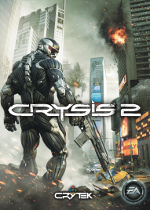Crysis 2 – Single-Player Campaign Review (360)
- Updated: 6th Apr, 2011
 For the uninitiated, the original Crysis was the kind of game that people used to benchmark their computer system. The recommended specification was so high it was positively stratospheric when it was originally released in 2007. It’s taken four years, but the series has now made the jump to multi-platform status; so when the opportunity came to check out the 360 version of Crysis 2, I jumped at the chance. Has it made a successful transition, you ask? The answer is a resounding yes. While it may not offer much originality, the single-player campaign is a wonderfully competent and enjoyable shooter, with some refinements to the original’s gameplay formula.
For the uninitiated, the original Crysis was the kind of game that people used to benchmark their computer system. The recommended specification was so high it was positively stratospheric when it was originally released in 2007. It’s taken four years, but the series has now made the jump to multi-platform status; so when the opportunity came to check out the 360 version of Crysis 2, I jumped at the chance. Has it made a successful transition, you ask? The answer is a resounding yes. While it may not offer much originality, the single-player campaign is a wonderfully competent and enjoyable shooter, with some refinements to the original’s gameplay formula.
The game immediately tries to lamp you with cutscenes and quickly establishes the action. It’s modern day and the island of Manhattan is under attack. Aliens have landed, and no, they’re not friendly; oh and there’s a virus which is making the populace generally unhappy. The whole set up reminded me a great deal of the premise from Battlefield: Los Angeles; to continue with the film metaphor this game feels as close to an FPS adaptation of Cloverfield as any game has come.
Soon, you’re nano-suited and booted, ready to kick some alien ass with nary but a pistol and a delightful set of abilities to hand. The right bumper toggles the suit’s cloak, making you nearly invisible and the left bumper toggles increased armour. They’re mutually exclusive and both drain the energy while active, so the game essentially is giving you a choice of whether to go silently stealthy or loud and proud. Eventually you get your hands on some heavier firepower than a simple handgun but to be honest, the real focus is in the abilities the suit affords you. Things have been streamlined this time around, ostensibly for the controller and console play.

Normally I would disdain this “dumbing down” of the mechanics, but in Crysis 2’s case, it really is a refinement of what worked and what should have been. In the first game, you had to split your focus between four areas: the default setting was a boost to Armour, but you could elect to emphasise Speed, Strength, or Stealth. Now, they have been rolled into the suit’s other functions and aren’t all mutually exclusive. As long as you have spare energy, the suit can also boost your sprinting speed, as well as enable you to hurl large barrels or kick cars and vans out of your way.
Being the type that likes being stealthy wherever and whenever possible, I would often move about the environments staying hidden and then crouch down out of view someplace and uncloak, waiting for the suit’s energy to recharge. The gauge refills quickly, so this is often a viable tactic. My only gripe is a concession which crops up in nearly all stealth-based games; the fact that enemies, after their “alert status” times out, just go back to their normal patrol routine. This would be fine if it was handled in the right way but it completely breaks the immersion for me if, after I have just dispatched a pile of enemy troops, the guy rounding the corner just cries out “All clear, false alarm!” and marches back to his post, ignoring the carnage. This happened more than a few times and I can’t fault the developers for giving me an out – I was playing on the lower “Soldier” level difficulty, after all.
Because of the series’ roots, I couldn’t help but think about the graphics as I was playing through the campaign. They’re really, really good. Perhaps not the “best ever” or even the best on a console, but what’s important for me simply was they kept me immersed in the experience. The graphics aren’t leaps and bounds above the original as I had been hoping, given that it had completed a four year development cycle, but it looks great on the 360. Some concessions have been made in terms of the environments, however; this is not the open world adventure of your father’s Crysis (and Far Cry) games [My father’s? o.0 – Ed]. On the plus side, the experience is tighter and though nearly all single-player games lead the player around by the nose, I was never left wondering where to go or what to do.
The game also does a superb job of presenting a city with towering buildings, and it lets you romp around in the way you see fit. They have made some effort to guide the player toward certain minor objectives, as well. In the first game you could whip out your binoculars and survey the situation, often over kilometres of land. This option returns but now an augmented reality HUD appears which highlights various “tactical options”, all of which may be exploited. I didn’t quite understand the numbering system they used, but still, it was useful to immediately get the lay of the land, at least insofar as these little options provided: a mounted heavy machinegun here, or a stealthy entrance there, etc. The other ability the visor affords you is to see things in “Nanovision” (PRESENTED IN… NANOVISION!). Apart from a cool, Predator-like filter, I didn’t see much use for this vision mode. It allows you to pick out enemies a little bit more rapidly and there are a couple of “dark places” where it must be employed but other than that, it drains the suit’s power too quickly for me to have found it very useful.
Without spoiling anything, there isn’t really much to say about the story in Crysis 2. It’s a little confusing at first, and when things become clear it’s a pretty straight shot toward the end. The characters are paper thin and although there are a couple of moments of good voice acting, the whole situation is pretty throwaway and forgettable. There aren’t really any twists that you don’t see coming from miles off, but having said all that, I still found the gameplay enjoyable enough to keep me going.
Speaking of progression, there are ways to unlock new abilities in the suit. As you progress through the levels, you will pick up “nano-catalyst” points which can be used like a kind of currency to unleash new powers within the suit.  Some will let you see the path of enemies, or of bullets arcing toward you, while others allow you to boost the stealth or armour facilities of the nanosuit. But I never really felt ultra powerful as I approached the end of the game. That is to say, I never felt ultra-powerful as compared to the very start of the game. The game does an admirable job of making you feel like a tooled-up supersoldier of the future, and although lots of shooters try to rationalise the reasoning behind why the player is such a badass one-man army, at least in the Crysis series we know it’s because of super advanced technology and pseudo-science.
Some will let you see the path of enemies, or of bullets arcing toward you, while others allow you to boost the stealth or armour facilities of the nanosuit. But I never really felt ultra powerful as I approached the end of the game. That is to say, I never felt ultra-powerful as compared to the very start of the game. The game does an admirable job of making you feel like a tooled-up supersoldier of the future, and although lots of shooters try to rationalise the reasoning behind why the player is such a badass one-man army, at least in the Crysis series we know it’s because of super advanced technology and pseudo-science.
A lot of people have been complaining about bugs and I’m sad to say I encountered a few. Only one was a game-breaking bug that caused me to reload to the last checkpoint. Most of the bugs seemed to be centred around the AI getting stuck on the geometry but honestly, it didn’t really happen enough for me to get irritated by it.
Summary:
I think Crysis 2 is worth jumping head-first into, for the single-player campaign alone which lasted me somewhere around 11 hours. I don’t think of the series for its multiplayer, but if the multi gets the thumbs up, (review coming later this month) it would probably tip Crysis 2 over the edge to be a must-buy at just under £40. While the game doesn’t feature a hugely cerebral plot, it’s good enough to get you shooting the baddies and the spit and polish shows that Crytek have matured somewhat as developers, at least in terms of their presentation and attention to detail. There are some incredible set-pieces in the game, and for a genre that seems to delight in the spectacular, Crysis 2 gets more than a few things right.
Crysis 2 is out now on PlayStation 3, Xbox 360 and PC.


Follow Us!